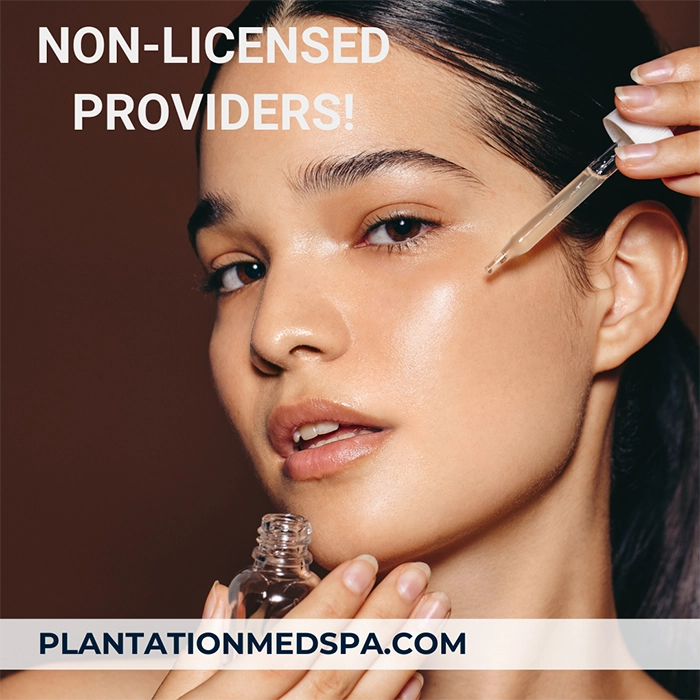Think Twice Before You Inject: The Dangers of Unlicensed Cosmetic Procedures
Introduction
Aesthetic procedures have become incredibly popular in recent years, with more people than ever seeking enhancements to their appearance. This article is about the dangerous complications of aesthetic procedures from nonlicensed providers.
From Botox injections to chemical peels and lip fillers, these treatments promise quick fixes with little downtime. They appeal to those who desire an immediate improvement in their looks without the need for surgery.
However, not all aesthetic procedures are created equal, and the person performing the treatment is critical to achieving safe and effective results.
Unfortunately, the growing demand for cosmetic enhancements has led to a rise in nonlicensed providers offering these services at a fraction of the cost. While it may seem attractive, the risks involved are significant.
Nonlicensed providers often need more training, experience, and understanding of medical protocols to perform aesthetic procedures safely. This can lead to a host of complications, some of which can be life-threatening.
Understanding the difference between licensed professionals and nonlicensed providers is essential to avoid these serious health risks.
While the cost may be a factor for many, compromising safety can have devastating consequences.
Table of Contents
1. Who Are Nonlicensed Providers?
2. Standard Aesthetic Procedures at Risk
3. Why Credentials Matter in Aesthetic Procedures
4. The Rise of Nonlicensed Providers in Aesthetics
5. Health Risks Associated with Unqualified Providers
6. Infection Risks from Nonlicensed Providers
7. Botched Results and Their Long-Term Impact
8. Legal Consequences of Using Nonlicensed Providers
9. Mental and Emotional Damage from Complications
10. What Drives People to Seek Nonlicensed Providers?
11. How to Verify a Provider’s Credentials
12. Stories of Aesthetic Procedure Failures
13. Preventing Complications: What You Can Do
14. The Future of Regulating Aesthetic Procedures
15. Frequently Asked Questions (FAQs)
16. Conclusion: Complications of Aesthetic Procedures from Nonlicensed Providers
17. References
1. Who Are Nonlicensed Providers?
Only licensed providers offer aesthetic treatments with the necessary medical training, certification, or legal authority.
Non-licensed providers might operate out of beauty salons, private homes, or makeshift clinics without medical boards or government health agencies’ oversight. These providers need to be certified in medicien,advanced nursing,dermatology, plastic surgery, or even basic healthcare practices, which is alarming given the invasive nature of many aesthetic procedures.
Many nonlicensed providers may mislead clients by falsely claiming to be certified or qualified.
In some cases, they might have taken informal courses or attended seminars on performing specific procedures, but this differs from the rigorous medical training required to become a licensed practitioner. With formal education and licensure, these providers can handle potential complications that could arise during or after treatment.
One of the critical dangers posed by nonlicensed providers is their need for knowledge regarding hygiene, sterilization, and safe practices. Procedures such as injections, laser treatments, or microneedling require precise knowledge of anatomy, medical protocols, and the proper use of equipment.
Without this, patients can suffer severe infections, scarring, and disfigurement.
2. Standard Aesthetic Procedures at Risk
Nonlicensed providers frequently offer several popular aesthetic procedures, and while they may seem straightforward, they come with significant risks when performed incorrectly.
One of the most common treatments offered by these providers is Botox injections. Botox involves injecting a neurotoxin into muscles to relax them and reduce the appearance of wrinkles.
If done by someone without the proper knowledge of facial anatomy, the injection can lead to droopy eyelids, asymmetry, or even breathing problems.
Another risky procedure often performed by nonlicensed providers is dermal fillers. These add volume to the lips, cheeks, or under the eyes. If injected improperly, fillers can cause blockages in blood vessels, leading to tissue death, vision loss, or severe infections.
Patients may also experience lumps, uneven swelling, and other disfigurements that require medical correction.
Chemical peels, used to remove layers of skin to reveal fresher skin underneath, can also be dangerous in the wrong hands. A nonlicensed provider might apply the solution too deeply or use an incorrect formula, resulting in burns, scarring, or permanent skin discoloration.
Other procedures like microneedling, laser treatments, and even non-surgical fat reduction treatments are often mishandled by nonlicensed providers, leading to long-term complications.
3. Why Credentials Matter in Aesthetic Procedures
The credentials of your aesthetic provider are more important than many people realize.
Licensed medical professionals, such as dermatologists and plastic surgeons, undergo years of education and rigorous training to safely perform procedures involving skin, muscles, and even the vascular system. These providers understand the complexities of human anatomy and how each aesthetic procedure interacts with the body.
Nonlicensed providers, however, often need more in-depth knowledge to perform these procedures safely. With the proper medical education, they may fully understand the implications of their actions, leading to higher risks of complications.
Licensed providers also have access to professional-grade equipment and medical facilities, ensuring procedures are performed in a sterile environment with proper medical protocols.
Additionally, licensed providers are bound by ethical and legal standards. They are accountable to medical boards and other governing bodies and must follow strict safety guidelines. A licensed provider is better equipped to handle emergencies or complications if something goes wrong.
In contrast, nonlicensed providers may not even recognize the signs of a problem, let alone know how to address it.
4. The Rise of Nonlicensed Providers in Aesthetics
In recent years, the demand for aesthetic procedures has skyrocketed, driven by the rise of social media, influencer culture, and the desire for “Instagram-ready” appearances.
This surge in popularity has opened the door for nonlicensed providers to step in and offer these services at a lower cost, making them attractive to individuals seeking budget-friendly options. However, this trend has also led to a disturbing increase in complications arising from poorly performed procedures.
Nonlicensed providers often advertise their services on social media platforms, offering discounted treatments that seem too good to pass up. They capitalize on people’s desire for quick, affordable enhancements without emphasizing the risks involved.
These providers might use flashy before-and-after photos or celebrity endorsements to gain credibility, but their qualifications often need to be improved.
The lack of strict oversight in many regions has also fueled the rise of these unregulated providers. In some areas, the laws regarding who can perform aesthetic procedures could be more transparent and more adequately enforced, making it easy for nonlicensed individuals to operate under the radar.
This trend is particularly concerning because it puts the safety and health of countless individuals at risk.
5. Health Risks Associated with Unqualified Providers
The health risks associated with nonlicensed providers of aesthetic procedures are vast and often severe.
One of the most common risks is infection, which can occur when procedures are performed in non-sterile environments or with improperly sanitized tools. Infections can range from mild to life-threatening, with some patients developing abscesses, cellulitis, or sepsis as a result of botched procedures.
Another serious risk is tissue necrosis, which happens when blood flow is cut off to an area due to improper injection techniques. For example, if a dermal filler is accidentally injected into a blood vessel, it can block circulation, leading to the death of the surrounding tissue.
This can cause permanent disfigurement and require extensive medical intervention to repair.
Nonlicensed providers are also more likely to make mistakes regarding the placement of injections, leading to asymmetry, drooping, or uneven results. In some cases, patients have reported losing function in muscles, experiencing paralysis in parts of the face, or suffering from vision loss after receiving treatments from unqualified providers.
These risks highlight the importance of seeking care from licensed professionals trained to minimize complications and deliver safe, effective results.
6. Infection Risks from Nonlicensed Providers
One of the most alarming risks posed by nonlicensed providers is the potential for severe infections. Unlike licensed professionals operating in sterile environments and adhering to strict hygiene standards, many nonlicensed providers lack access to medical-grade facilities or equipment.
Often, they may perform procedures in makeshift environments such as home-based salons or unregulated clinics, which are not subject to regular inspections or health regulations.
The risk of infection arises from multiple factors, including using unsterilized tools, improper handling of materials like needles, or even using expired products. When these procedures involve breaking the skin, as with injections or microneedling, bacteria can quickly enter the body.
Infections like staph or MRSA (methicillin-resistant Staphylococcus aureus) can cause painful, swollen abscesses that may require surgical intervention or lead to more severe conditions like blood infections or sepsis if left untreated.
For patients, an infection following an aesthetic procedure can not only be painful but may also leave long-term damage. Scarring, tissue damage, and permanent skin discoloration are common side effects of untreated infections. In severe cases, infections can lead to hospitalization and even death.
Given these risks, only licensed providers who follow stringent health protocols must be trusted, ensuring the procedures are performed safely in clean and controlled environments.
7. Botched Results and Their Long-Term Impact
In addition to the immediate health risks, one of the most common complications of aesthetic procedures performed by nonlicensed providers is botched results.
Unlike licensed professionals with extensive training in facial anatomy and injection techniques, nonlicensed providers often lack the necessary skills and precision to achieve aesthetically pleasing outcomes. This lack of expertise can result in disastrous results that fall short of expectations and may require further medical intervention.
Botched aesthetic procedures often involve asymmetry, uneven skin texture, overfilling, or lumps under the skin caused by improper injection of dermal fillers. In more severe cases, patients may experience issues like drooping eyelids, distorted facial expressions, or even permanent nerve damage from poorly placed injections of Botox or other neurotoxins.
These aesthetic failures are not just cosmetic—they can lead to emotional distress, a loss of self-confidence, and a need for expensive corrective procedures to fix the damage.
Unfortunately, the effects of botched procedures can be long-lasting and, in some cases, irreversible. Patients may be left with permanent disfigurements, scarring, or functional impairments. Even when corrective procedures are possible, they can be costly, painful, and require significant downtime.
The emotional toll of dealing with these complications can also be profound, as individuals must grapple with the consequences of a decision that seemed simple and affordable at the time but turned into a traumatic ordeal.
8. Legal Consequences of Using Nonlicensed Providers
When a person suffers from complications after an aesthetic procedure performed by a nonlicensed provider, they often face an uphill battle in seeking legal recourse.
Unlike licensed medical professionals who carry malpractice insurance and/or are held accountable by regulatory boards, nonlicensed providers typically operate without such protections. This lack of oversight means it can be challenging for patients to pursue compensation or justice when things go wrong.
Legal actions against nonlicensed providers are often complicated because these individuals may operate illegally or without proper documentation. They may disappear, shut down their operations, or deny responsibility for any adverse outcomes.
Furthermore, proving negligence or misconduct in court can be difficult because they are subject to a different level of professional scrutiny than licensed practitioners.
This lack of accountability can result in significant financial and emotional burdens for patients. Not only do they face the costs associated with correcting the botched procedure or treating medical complications, but they may also find themselves unable to recover damages from the individual responsible.
This underscores the importance of carefully vetting any provider before an aesthetic procedure and ensuring they are appropriately licensed and insured.
9. Mental and Emotional Damage from Complications
The complications from aesthetic procedures performed by nonlicensed providers extend far beyond physical consequences. Many patients who experience botched results or severe health issues also suffer from significant mental and emotional distress.
Aesthetic procedures are often sought to boost self-esteem or enhance one’s appearance. Still, when the results are disastrous, it can have the opposite effect, leading to anxiety, depression, and a diminished sense of self-worth.
Patients who have undergone failed procedures may experience feelings of embarrassment or shame about their appearance, especially if the complications are visible and difficult to hide. The constant reminder of their experience can make it hard for them to feel confident in social settings or their daily lives.
For some, this emotional burden is compounded by regret and guilt as they grapple with the decision to seek treatment from a nonlicensed provider.
In more severe cases, the emotional toll can lead to long-term mental health issues, such as body dysmorphia or post-traumatic stress disorder (PTSD). These conditions can be exacerbated by the financial strain of needing corrective surgery or medical treatments, as well as the feeling of being taken advantage of by an unqualified provider.
For many, the emotional recovery can take years, with some never fully regaining the confidence they once had.
10. What Drives People to Seek Nonlicensed Providers?
One of the critical questions to consider is why people turn to nonlicensed providers in the first place despite the apparent risks. In many cases, the primary motivation is cost.
Aesthetic procedures can be expensive, and for individuals on a tight budget, the significantly lower prices offered by nonlicensed providers seem like a way to achieve their desired results without breaking the bank. However, this decision is often a costly mistake in the long run.
Another factor is convenience. Nonlicensed providers often operate without the lengthy wait times or appointment processes typical of licensed professionals. They may offer procedures with little to no delay, appealing to individuals who want quick results.
Additionally, the allure of informal settings, such as home-based clinics, can make the experience feel more accessible or less intimidating than a medical office.
Social media and online marketing also play a significant role in driving people to nonlicensed providers. Influencers and unregulated beauty pages may promote these providers, showing off glamorous before-and-after photos that make the treatments seem safe and effective.
Many people only realize the risks once it’s too late, as these providers often need to pay more attention to the importance of qualifications and the potential for complications.
11. How to Verify a Provider’s Credentials
Verifying a provider’s credentials before undergoing an aesthetic procedure is critical to ensuring your safety. The first step is to confirm that the provider is licensed to perform the specific procedure you are considering.
This usually means checking if the provider holds a medical license as a dermatologist, plastic surgeon, or another qualified medical professional. This information can often be found online through medical boards or government websites.
It would help to inquire about the provider’s education and training. A reputable provider will have undergone specialized training in aesthetic procedures and will be able to provide proof of their qualifications.
Additionally, asking about their experience with the specific treatment you seek can help ensure they have the necessary expertise to achieve safe and effective results.
Lastly, looking for reviews or testimonials from previous patients is essential. Licensed providers often have a track record of satisfied clients who can vouch for their professionalism and skill.
Be wary of providers who need a professional website, have poor reviews, or cannot provide references.
Taking the time to thoroughly vet a provider before proceeding with a procedure can save you from complications and heartache.
12. Stories of Aesthetic Procedure Failures
There are countless real-life stories of individuals who have suffered devastating consequences after choosing to undergo aesthetic procedures with nonlicensed providers. These cautionary tales highlight the importance of thoroughly vetting any provider before committing to a treatment.
One such story involves a woman who received lip filler injections from an unlicensed provider at a beauty salon.
After the treatment, her lips became swollen and disfigured due to a severe allergic reaction. She later learned that the provider had used a counterfeit product not approved for medical use.
Another case involved a man who sought Botox injections from a nonlicensed provider offering discounted services on social media. After the procedure, he experienced drooping in one eyelid and numbness in his forehead.
It was later discovered that the Botox used was expired, and the provider had no formal training in administering neurotoxins. Corrective surgery was required to repair the damage, costing him significantly more than the original treatment.
These stories are powerful reminders that the short-term savings offered by nonlicensed providers often come at a much higher cost in the long run.
The risks associated with these providers are not worth the potential physical and emotional complications.
13. Preventing Complications: What You Can Do
The best way to prevent complications from aesthetic procedures is to ensure that you are working with a licensed, qualified provider.
Start by doing thorough research before booking any treatment. Check the provider’s medical credentials, look for reviews from past clients, and ask about their experience with the procedure you are considering.
Be bold and ask tough questions about their qualifications and the safety protocols they follow.
Another crucial step is to avoid being swayed by low prices or fast results. While saving money may be tempting, remember that aesthetic procedures involve your health and appearance, and cutting corners can lead to significant harm.
Investing in a trusted provider is always better, even if it means paying more or waiting longer for an appointment. Quality care and safety should always come first.
Finally, it’s essential to trust your instincts. If something feels off or the provider seems evasive when answering your questions, it’s better to walk away. Reputable providers will be open, transparent, and willing to discuss any concerns you may have.
Taking these precautions can help you avoid the dangers associated with nonlicensed providers and ensure a safe, positive experience with your aesthetic procedure.
14. The Future of Regulating Aesthetic Procedures
As the demand for aesthetic procedures continues to grow, so does the need for stricter regulations and enforcement to protect consumers.
Currently, regulations regarding who can perform specific aesthetic procedures vary widely from one region to another, leading to loopholes that allow nonlicensed providers to operate with minimal oversight. This lack of uniformity creates significant risks for individuals seeking these treatments.
Moving forward, governments and medical boards need to implement clearer, stricter guidelines for who is qualified to perform aesthetic procedures. This includes more rigorous licensing requirements, regular inspections of facilities, and harsher penalties for individuals found to be operating without the proper credentials.
Public awareness campaigns may also be necessary to educate consumers about the risks of nonlicensed providers and the importance of seeking treatment from qualified professionals.
In the long term, these measures will help reduce the number of complications and protect individuals from the dangerous practices of nonlicensed providers.
By ensuring that only trained, licensed professionals are allowed to perform aesthetic procedures, we can help create a safer, more regulated industry that prioritizes the well-being of patients.
15. Frequently Asked Questions (FAQs) about Complications of Aesthetic Procedures from Nnonlicensed Providers
Q1: What are nonlicensed providers in aesthetic procedures?
Concise Answer: Nonlicensed providers offer aesthetic procedures without proper medical certification or training.
Detailed Answer: Nonlicensed providers perform aesthetic procedures such as Botox, fillers, and chemical peels without the necessary medical licenses or formal training in the field. These individuals often operate in unregulated environments and lack the qualifications to ensure safety, leading to increased risks of complications.
Compared to certified professionals, they are not accountable to medical boards, making them far less trustworthy for medical-grade procedures.
Q2: What are the risks of using nonlicensed providers for Botox?
Concise Answer: Using nonlicensed providers for Botox can result in drooping eyelids, asymmetry, infections, and long-term damage.
Detailed Answer: Botox is a neurotoxin that requires precise injection techniques to achieve safe, effective results.
Nonlicensed providers often lack the training needed to administer Botox properly, leading to complications such as facial asymmetry, unintended paralysis of muscles, and infections due to poor hygiene.
In some cases, expired or counterfeit Botox products may be used, further increasing the risk of adverse effects.
Q3: How do I verify if an aesthetic provider is licensed?
Concise Answer: Verify an aesthetic provider’s license by checking their medical credentials through government health agencies or medical boards.
Detailed Answer: To confirm whether an aesthetic provider is licensed, ask for their qualifications and medical license number. You can verify this information by visiting your country’s medical board website or health department, which often maintains public databases of licensed practitioners.
Checking online reviews and seeking referrals from trusted professionals are also effective ways to ensure your provider is qualified.
Q4: What should I do if I experience complications after a procedure?
Concise Answer: If you experience complications, seek medical help from a licensed professional immediately.
Detailed Answer: After an aesthetic procedure, if you notice signs of complications such as swelling, infection, asymmetry, or unusual pain, it’s crucial to consult a licensed medical professional as soon as possible.
Early intervention can prevent further damage and address infections or tissue damage. Refrain from returning to the nonlicensed provider, as they may need more skills or resources to manage complications effectively.
Q5: Can complications from nonlicensed providers be corrected?
Concise Answer: In many cases, complications from nonlicensed providers can be corrected, but it often requires expensive medical intervention.
Detailed Answer: While some complications from nonlicensed providers can be reversed through corrective procedures performed by licensed professionals, the process can be lengthy and costly.
Issues such as uneven filler injections or nerve damage may require surgical interventions or dissolving treatments.
However, in severe cases, some complications, such as scarring or tissue death, may be permanent.
Q6: Why do nonlicensed providers offer cheaper procedures?
Concise Answer: Nonlicensed providers offer cheaper procedures because they cut safety measures, training, and proper equipment costs.
Detailed Answer: Nonlicensed providers often operate without the overhead expenses licensed professionals incur, such as high-quality medical equipment, sterile environments, and malpractice insurance.
Additionally, they typically lack formal medical training, which allows them to undercut prices.
However, these cost savings come at the expense of safety, increasing the risk of complications that could be far more expensive to fix.
Q7: Are nonlicensed providers breaking the law?
Concise Answer: Nonlicensed providers operate illegally when performing medical-grade aesthetic procedures in many jurisdictions.
Detailed Answer: The legality of nonlicensed providers varies depending on the region, but in many areas, performing medical aesthetic procedures without a valid license is illegal.
These providers may be breaking laws related to medical practice, consumer protection, and health standards. If caught, they can face fines, legal action, and even criminal charges, depending on the severity of the violation.
Q8: How common are infections from aesthetic procedures by nonlicensed providers?
Concise Answer: Infections are a common complication of aesthetic procedures performed by nonlicensed providers due to poor hygiene.
Detailed Answer: Infections are prevalent in procedures performed by nonlicensed providers because they often lack access to sterile medical environments.
Procedures involving injections or skin punctures, like Botox or microneedling, can introduce bacteria into the body if proper sanitation protocols are not followed. These infections can range from mild to severe, requiring antibiotics or, in extreme cases, surgical intervention.
Q9: What is tissue necrosis, and how does it occur in aesthetic procedures?
Concise Answer: Tissue necrosis is tissue death, which can occur if a filler is improperly injected into a blood vessel, blocking circulation.
Detailed Answer: Tissue necrosis occurs when blood flow is restricted to a particular area, causing the tissue to die. In aesthetic procedures, this can happen if dermal fillers are accidentally injected into a blood vessel, cutting off circulation to the surrounding skin.
This complication is more common when nonlicensed providers perform procedures requiring more anatomical knowledge and expertise. Tissue necrosis can result in scarring, disfigurement, or even the need for surgical correction.
Q10: Can nonlicensed providers use counterfeit products?
Concise Answer: Nonlicensed providers often use counterfeit or expired products, which can lead to harmful complications.
Detailed Answer: Nonlicensed providers may use counterfeit products like fake Botox or filler materials to cut costs.
These counterfeit products may not be safe for use in the human body and can cause severe allergic reactions, infections, or poor aesthetic outcomes. Expired products can also lose effectiveness or break down unpredictably, increasing the risk of complications.
Q11: How can I avoid nonlicensed providers?
Concise Answer: Avoid nonlicensed providers by thoroughly researching and verifying the credentials of any aesthetic professional before treatment.
Detailed Answer: To avoid nonlicensed providers, constantly research your aesthetic professional before booking an appointment. Look for official certifications, verify their medical license with local regulatory boards, and read online reviews or ask for recommendations from trusted sources.
Be wary of providers who offer suspiciously low prices or operate out of unconventional settings, as these can be red flags that the provider is not licensed.
Q12: What are the signs of a botched aesthetic procedure?
Concise Answer: Signs of a botched procedure include asymmetry, excessive swelling, infection, and abnormal results.
Detailed Answer: Common signs that an aesthetic procedure has gone wrong include visible asymmetry in the treated area, lumps or bumps under the skin, persistent swelling, and signs of infection like redness, warmth, and pain.
Additionally, results that look unnatural or far from the desired outcome can indicate a poorly performed procedure. In such cases, seeking a consultation with a licensed medical professional is essential to address complications.
Q13: Can nonlicensed providers cause permanent damage?
Concise Answer: Yes, nonlicensed providers can cause permanent damage, including scarring, tissue death, and nerve damage.
Detailed Answer: Nonlicensed providers can cause a range of permanent complications, including scarring, tissue necrosis, and nerve damage.
Because these providers lack the proper training to perform procedures safely, they may inject substances incorrectly or use unsafe techniques, leading to long-lasting or irreversible harm.
Corrective surgery can sometimes help, but not all damage can be undone, mainly when severely affected nerves or tissues are affected.
Q14: Are non-surgical aesthetic procedures safer with licensed providers?
Concise Answer: Non-surgical aesthetic procedures are significantly safer when performed by licensed professionals with medical training.
Detailed Answer: Non-surgical aesthetic procedures, such as Botox or filler injections, carry fewer risks when performed by licensed providers with rigorous medical training.
These professionals understand anatomy, proper injection techniques, and how to handle complications should they arise. Their use of medical-grade equipment and adherence to hygiene standards further minimizes the risk of infections and other issues.
Q15: How can I recover from a botched procedure?
Concise Answer: Recovery from a botched procedure may require corrective treatments from a licensed professional.
Detailed Answer: If you’ve experienced a botched procedure, the first step is to consult a licensed medical professional specializing in aesthetic treatments.
Depending on the complication, you may need corrective surgery, dissolving treatments, or other medical interventions to address the issue.
Recovery time and the extent of correction needed will vary based on the severity of the complication, but seeking prompt medical attention is critical to preventing further harm.
16. Conclusion: Complications of Aesthetic Procedures from Nonlicensed Providers
In summary, while popular and often seen as simple enhancements, aesthetic procedures carry significant risks when performed by nonlicensed providers. From infections and botched results to permanent tissue damage and emotional distress, the complications can be severe and life-altering.
Despite the allure of lower costs and quick appointments, choosing an unqualified provider can result in devastating consequences that far outweigh any initial savings. The importance of seeking licensed, trained professionals regarding your health and safety cannot be overstated.
By understanding the risks associated with nonlicensed providers, you can make more informed decisions about your aesthetic treatments. Ensuring your provider is credentialed correctly, operating in a sterile environment, and using safe, approved products will significantly reduce the likelihood of complications.
While the upfront cost may be higher, the peace of mind and long-term benefits of a safe procedure are invaluable.
Looking to the future, stricter regulations and increased public awareness will be crucial in curbing the rise of nonlicensed providers. As the aesthetic industry continues to grow, so must the measures to protect individuals from the dangerous practices of unqualified providers.
Educating yourself and others about these risks can help create a safer environment for everyone seeking aesthetic enhancements.
This article talked about the complications of aesthetic procedures from nonlicensed providers.
Transform Your Look with the Different Licensed Treatments at Plantation Med Spa
Experience the revolutionary power of licensed treatments at Plantation Med Spa, Florida. Our state-of-the-art treatments revitalize and rejuvenate, offering you a path to radiant, youthful skin. Why wait to unlock your best self?
Call us now at (954) 595-2607 or book online. Your journey to flawless skin begins with just a click or a call.
Embrace the beauty, embrace innovation – Embrace You.
17. References
- Dr. Chadi Dahabra
- Plantation Med Spa
- West Palm Beach Med Spa
- Beverly Hills Wellness Center & Med Spa
- The Importance of Injuries Attributable to Cosmetic Procedures Performed by Unlicensed Individuals in the United States
- State medical board regulation of minimally invasive cosmetic procedures
- Aesthetic Surgical Procedures in Men: Major Complications and Associated Risk Factors
- Aesthetic Breast Surgery and Concomitant Procedures: Incidence and Risk Factors for Major Complications in 73,608 Cases
- Complications of Botox and their Management
- Complications of botulinum toxin A use in facial rejuvenation
- Aesthetic training concept during plastic surgery residency – Opportunity or risk?
- Complications of aesthetic medicine procedures: five case studies
- Fatal Complications of Aesthetic Techniques: The Gluteal Region
- Complications associated with cutaneous aesthetic procedures
- Cosmetics, Regulations, and the Public Health Understanding the Safety of Medical and Other Products
- Nanomaterials in Cosmetic Products: the Challenges with regard to Current Legal Frameworks and Consumer Exposure
- A systematic review of global legal regulations on the permissible level of heavy metals in cosmetics with particular emphasis on skin lightening products




